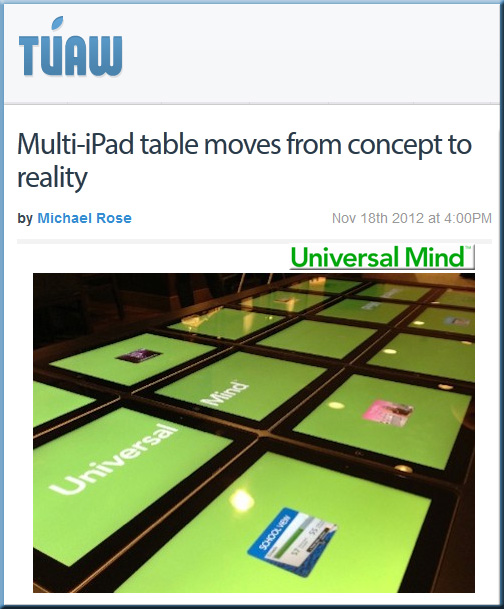— With thanks to Custer for this resource
Also see:

— from universalmind.com –– also see this posting re: the above iPad table
With a special thanks going out to Mr. Brad Kortman at Calvin College for these resources
.
Also consider:
— With thanks to Custer for this resource
Also see:

— from universalmind.com –– also see this posting re: the above iPad table
With a special thanks going out to Mr. Brad Kortman at Calvin College for these resources
.
Also consider:
Description of video:
Stephen Harris, Principal of Northern Beaches Christian School, gives a short tour of the SCIL Building, an open-plan, multi-modal learning space for student-directed learning. The SCIL Building features spaces and furniture than foster a range of learning modes and styles.
.
Also see:
.
.
.
Addendum on 11/14/12:
.
The Teaching and Learning Spaces Working Group (TLSWG) endeavors to enhance teaching and learning at McGill by creating a vision for teaching and learning space development that is aligned with University strategic directions. Its mandate is to…
34 creative [pieces of] furniture that stand out from the rest — from hongkiat.com by Alvaris Falcon
Example:
Broadband, broadcast lines erode as TV shifts to a mobile, multiscreen media landscape — from by Joseph O’Halloran back from 2/11/2012
Excerpt:
[Q2 2012] research from online video firm Ooyala has confirmed the trend that viewers around the world are embracing mobile, multiscreen experiences for both long-form and short-form content.
The Ooyala Global Video Index Report for the second quarter of 2012 reveals that online video uptake may be rising across the world but that engagement patterns vary by country and region, with a number of global video hot spots. For example, in the UK the survey revealed that 15% of the total time spent watching online video occurs on mobile phones and tablets, while 11% of the total time spent watching online video in China occurs on tablets and smart phones.
Steelcase Education Solutions showcased its
collaborative learning furniture at CEFPI in San Antonio.
.
Steelcase Education Solutions’ furniture
focuses on the concept of active learning.
.
Excerpt:
GRAND RAPIDS, Mich. — The future of classroom furniture can now be found in more compact and flexible designs. Education Solutions, a division of Steelcase Inc., has redefined its approach to classroom furniture by incorporating designs that accommodate the needs of students, teachers and the educational approach of the future.
From DSC:
Being involved with planning our Next Generation Smart Classroom, what I especially appreciate about what Steelcase has done here is to allow for more flexible seating solutions. Faculty can have students quickly and efficiently re-arrange their seating configurations in order to enable greater collaboration. There are several other advantages/features in their offerings, but I wanted to highlight that one.
Do ‘glassboards’ have a future in the classroom? — from lavalnews.ca by Martin C. Barry
Interactive glass for educational purposes ‘is in its infancy,’ insists the SWLSB’s director of educational services
.
20 things educators need to know about learning spaces — from newsroom.opencolleges.edu.au by Miriam Clifford
Excerpt:
The 21stcentury is challenging old notions of learning spaces.
The idea that students must be seated at desks working in rows is quickly becoming archaic. Technology and collaborative work environments are changing the design of learning spaces. Experts hope that the emerging paradigm will translate into improved learning spaces and influence future architectural design.
Stephen Heppell and expert panelists recently spoke in Australia about physical spaces in The changing face of Education. Heppell, an international expert in the fields of learning, new media and technology, is known for his “eyes on the horizon, feet on the ground philosophy”.
He has moved countless organizations into the digital age.
From Library learning spaces as curated by Anne Whisken
Design, creation & management of library learning spaces.
.
Modern Architecture: Dalian Public Library by 10 Design, Dalian, China
 |
| Modern Architecture: Dalian Public Library by 10 Design, Dalian, China © 10 Design |
.
Welcome to the ‘Hive’: Harvard’s new classroom — from CLO by Frank Kalman
Harvard Business School’s recently launched “Hive” classroom is fit to equip learners with three modern components to business leadership: teamwork, collaboration and flexibility.
.
The classroom in 2020 — from Forbes.com by George Kembel
The next decade will bring an end to school as we know it.

.
Reconceptualising the School Library as Collaborative Makerspace | Services to Schools
Collaborative teaching: What might it look like?
Indoor navigation takes signals and sensors — from spectrum.ieee.org by Tekla Perry
Excerpt:
Indoor navigation. You’re going to be hearing a lot about it over the coming months. Apple, having recently dumped Google’s mapping technology from its mobile devices, will be trying to beat Google at the mapping game. Google will fight back with more and more features, many likely intended for use indoors. (I expect to see some mapping demos at the upcoming iPhone 5 introduction later this week.)
From DSC: